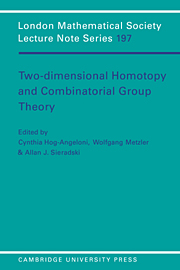Book contents
- Frontmatter
- Contents
- Editors' Preface
- Addresses of Authors
- I Geometric Aspects of Two-Dimensional Complexes
- II Algebraic Topology for Two Dimensional Complexes
- III Homotopy and Homology Classification of 2-Complexes
- IV Crossed Modules and Π2 Homotopy Modules
- V Calculating Generators of Π2
- VI Applications of Diagrams to Decision Problems
- VII Fox Ideals, N-Torsion and Applications to Groups and 3-Manifolds
- VIII (Singular) 3-Manifolds
- IX Cancellation Results for 2-Complexes and 4-Manifolds and Some Applications
- X J. H. C. Whitehead's Asphericity Question
- XI Zeeman's Collapsing Conjecture
- XII The Andrews-Curtis Conjecture and its Generalizations
- Bibliography
- Index
VII - Fox Ideals, N-Torsion and Applications to Groups and 3-Manifolds
Published online by Cambridge University Press: 20 January 2010
- Frontmatter
- Contents
- Editors' Preface
- Addresses of Authors
- I Geometric Aspects of Two-Dimensional Complexes
- II Algebraic Topology for Two Dimensional Complexes
- III Homotopy and Homology Classification of 2-Complexes
- IV Crossed Modules and Π2 Homotopy Modules
- V Calculating Generators of Π2
- VI Applications of Diagrams to Decision Problems
- VII Fox Ideals, N-Torsion and Applications to Groups and 3-Manifolds
- VIII (Singular) 3-Manifolds
- IX Cancellation Results for 2-Complexes and 4-Manifolds and Some Applications
- X J. H. C. Whitehead's Asphericity Question
- XI Zeeman's Collapsing Conjecture
- XII The Andrews-Curtis Conjecture and its Generalizations
- Bibliography
- Index
Summary
In this chapter, we introduce Fox ideals Im(G0) for each m ≥ 0 by means of finitely generated free partial resolutions of the group G, and describe a practical method for computing Im(G) using representations of G. Fox ideals provide powerful tests for determining the rank of G (for m = 1), the deficiency of G (m = 2) and the homological dimension of G (m ≥ 2). These are derived in §§1–2, and some (partly new) applications are given.
N-torsion groups Nm(G), introduced in §3, are the direct analogues of the Whitehead group Wh(G), with ℤG replaced by ℤG/Im(G). In general, however, Nm(G) turns out to be much richer than Wh(G), and a practical evaluation method is described (using again representations of G), which yields non-trivial values in a large variety of cases. For m = 1, they distinguish Nielsen equivalence classes of generating systems of G, and hence isotopy or homeomorphy classes of Heegaard splitting of 3-manifolds (see §4). For m = 2 (or even m ≥ 2), N-torsion provides a crucial tool for the distinction of (simple)-homotopy classes of m-dimensional cell complexes (see §5). Here Fox ideals and N-torsion values are direct and natural generalizations of the bias modulus and the bias invariant respectively, as introduced in Chapter III (see 5.4 below).
Fox ideals and N-torsion and their preliminary versions have been discovered in different contexts and with varying degree of generality by several authors; see, for example, [Dy85], [Ho-AnLaMe91], [Ho-An88], [LuMo91] or [Me90]. Our treatment here is closest to [Lu9l2], where the independence from particular resolutions of G was achieved through matrix representations, and Im(G) and Nm(G) have been established as group theoretic invariants.
- Type
- Chapter
- Information
- Two-Dimensional Homotopy and Combinatorial Group Theory , pp. 219 - 250Publisher: Cambridge University PressPrint publication year: 1993
- 4
- Cited by



